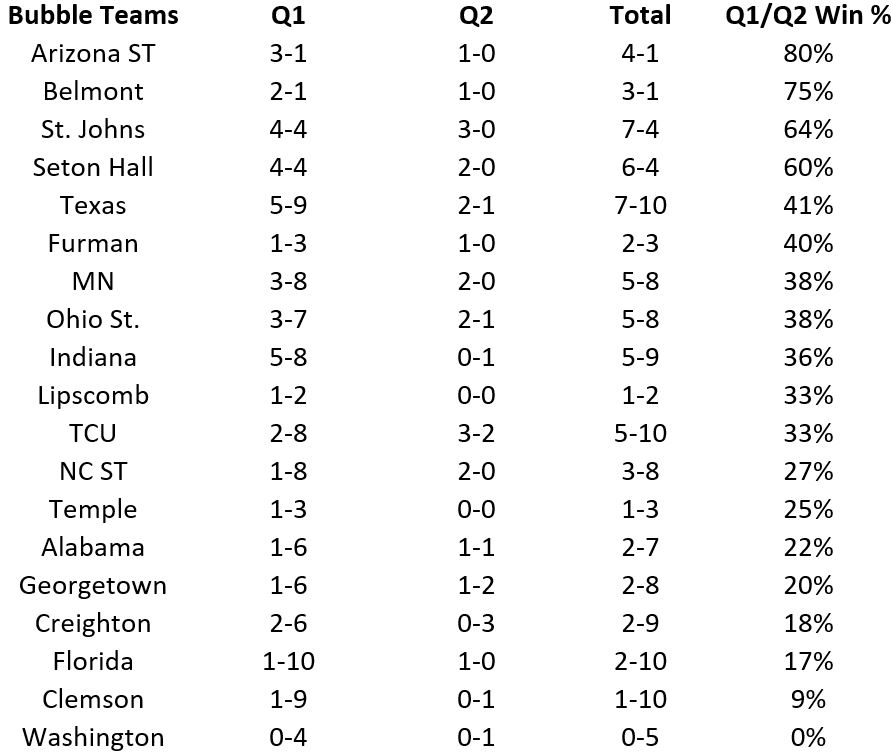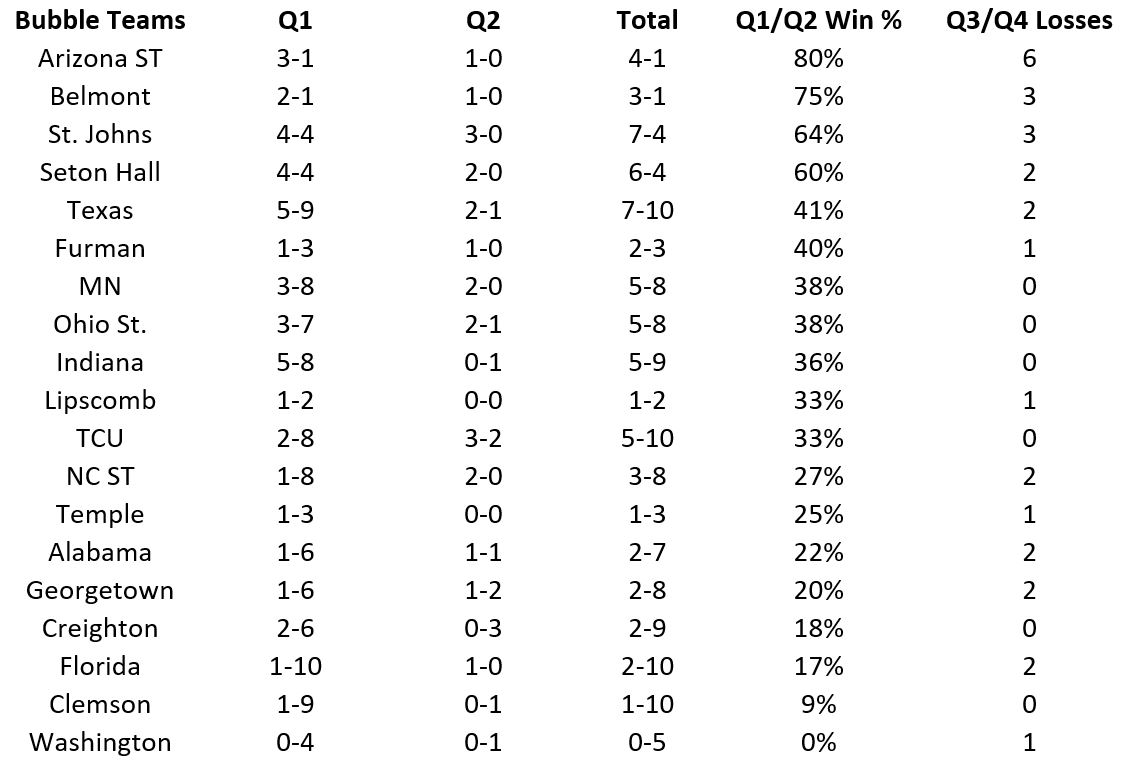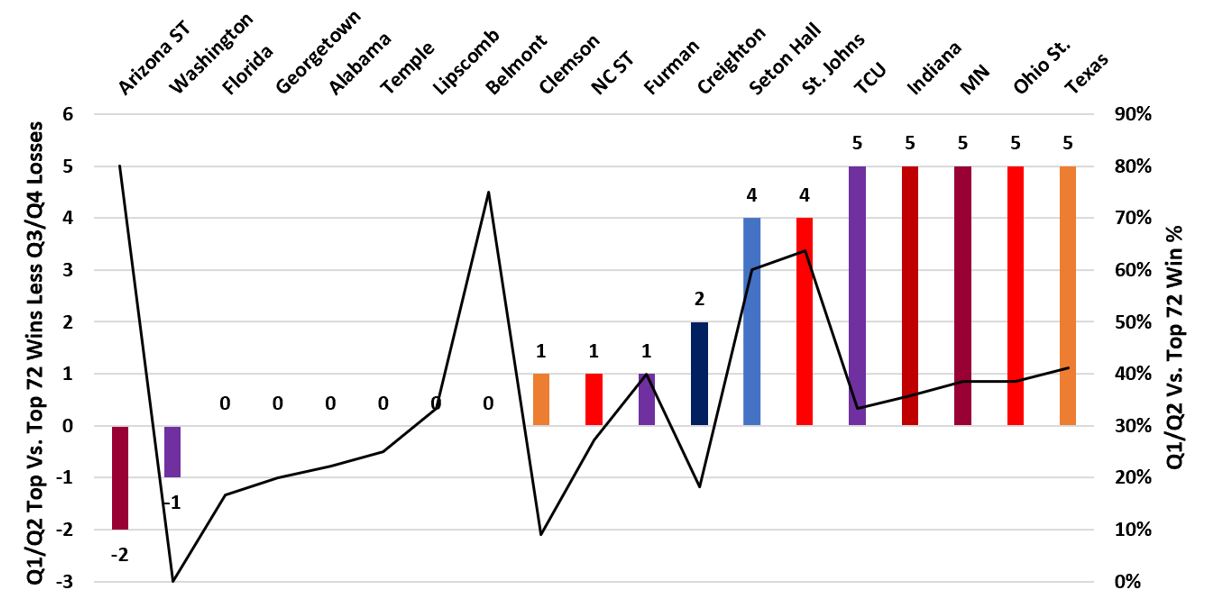With the tourney right around the corner, a lot of focus will be on Q1 and Q2 victories. I realized that this might not be a fair measuring stick. While watching the Ohio St. game on Thursday, I saw that 3/4 of their Q1 wins were against teams that were on the bubble or not in tourney contention at all. That got me thinking…
What if we looked at teams’ quadrant profiles, but excluded Q1 and Q2 games (both wins and losses) against teams that will not be playing in the field of 68 (via an at-large bid).
Therefore, the wins against teams like Nebraska, Missouri, Oregon, Penn State, (neutral or away) among others; are excluded when analyzing Q1 and Q2 profiles.
What defines a tournament team? I am using the top 72 teams as of 3/8 on Bracketmatrix.com. I included the “First Four Out” because I think other bubblers should get credit for beating the teams on the cusp.
Here are the results sorted by Q1/Q2 Win %:

Initial Thoughts:
• Washington has not beaten a team in contention for a tourney bid
• Belmont has not had many opportunities, but has taken advantage when the Q1/Q2 opportunities have presented themselves
• Seton Hall and St. Johns have a winning record against tourney contenders
• Texas and St. Johns are head and shoulders above the field in quantity of wins against tourney contenders
• All teams under TCU leave a lot to be desired, especially Florida and Clemson
Q1/Q2 wins and losses don’t tell the whole story. Let’s also look at the above teams’ Q3/Q4 losses:

Initital Thoughts:
• AZ St. has six Q3/Q4 losses, more than double anyone else on the bubble
• MN, Ohio St. and Indiana have a better Q1/Q2 win percentage than most bubble foes and also have zero Q3/Q4 losses
• How is Florida solidly in the field in so many bracket projections!?
And finally, I wanted to show a visual of this data. The graph below has a dual axis. The bars for each team are Q1/Q2 wins against tourney team minus Q3/Q4 losses (every good win is reduced by every bad loss). The line represents teams’ Q1/Q2 win percentage. The teams are ordered by net wins, and ties are further ordered by win%:

My Conclusion:
• Texas is in. Book it.
• Whoever is called first on Selection Sunday out of MN, Ohio St. and Indiana, the other two teams should be feeling pretty damn good about their chances
• The Pac12 is a one-bid league
• If 12 out of these 18 teams will make the tourney, there is a fairly steep drop off after Seton Hall
• Florida, Georgetown, Alabama, and Temple better make some serious noise in conference tournaments
• Gophers are a LOCK (emphasis on capitalization) and have a superior profile to many bubble teams if the bubble does shrink considerably
Potential Flaws with Analysis
• Q1 and Q2 wins against non-tournament competition do carry value which is which is not being factored in this analysis (especially road wins)
• Not all Q1 and Q2 wins are equal. A win at Duke or at Virginia is better than a win at home against Purdue
• Not all Q3 and Q4 losses are equal. A loss to Providence at home isn’t as detrimental as a loss to Texas State A&T of El Paso at home.
• I may have missed a data point for a team or two.
What are your thoughts Gopherhole? I am ready for the onslaught of abuse and personal putdowns ��
What if we looked at teams’ quadrant profiles, but excluded Q1 and Q2 games (both wins and losses) against teams that will not be playing in the field of 68 (via an at-large bid).
Therefore, the wins against teams like Nebraska, Missouri, Oregon, Penn State, (neutral or away) among others; are excluded when analyzing Q1 and Q2 profiles.
What defines a tournament team? I am using the top 72 teams as of 3/8 on Bracketmatrix.com. I included the “First Four Out” because I think other bubblers should get credit for beating the teams on the cusp.
Here are the results sorted by Q1/Q2 Win %:

Initial Thoughts:
• Washington has not beaten a team in contention for a tourney bid
• Belmont has not had many opportunities, but has taken advantage when the Q1/Q2 opportunities have presented themselves
• Seton Hall and St. Johns have a winning record against tourney contenders
• Texas and St. Johns are head and shoulders above the field in quantity of wins against tourney contenders
• All teams under TCU leave a lot to be desired, especially Florida and Clemson
Q1/Q2 wins and losses don’t tell the whole story. Let’s also look at the above teams’ Q3/Q4 losses:

Initital Thoughts:
• AZ St. has six Q3/Q4 losses, more than double anyone else on the bubble
• MN, Ohio St. and Indiana have a better Q1/Q2 win percentage than most bubble foes and also have zero Q3/Q4 losses
• How is Florida solidly in the field in so many bracket projections!?
And finally, I wanted to show a visual of this data. The graph below has a dual axis. The bars for each team are Q1/Q2 wins against tourney team minus Q3/Q4 losses (every good win is reduced by every bad loss). The line represents teams’ Q1/Q2 win percentage. The teams are ordered by net wins, and ties are further ordered by win%:

My Conclusion:
• Texas is in. Book it.
• Whoever is called first on Selection Sunday out of MN, Ohio St. and Indiana, the other two teams should be feeling pretty damn good about their chances
• The Pac12 is a one-bid league
• If 12 out of these 18 teams will make the tourney, there is a fairly steep drop off after Seton Hall
• Florida, Georgetown, Alabama, and Temple better make some serious noise in conference tournaments
• Gophers are a LOCK (emphasis on capitalization) and have a superior profile to many bubble teams if the bubble does shrink considerably
Potential Flaws with Analysis
• Q1 and Q2 wins against non-tournament competition do carry value which is which is not being factored in this analysis (especially road wins)
• Not all Q1 and Q2 wins are equal. A win at Duke or at Virginia is better than a win at home against Purdue
• Not all Q3 and Q4 losses are equal. A loss to Providence at home isn’t as detrimental as a loss to Texas State A&T of El Paso at home.
• I may have missed a data point for a team or two.
What are your thoughts Gopherhole? I am ready for the onslaught of abuse and personal putdowns ��
Last edited:
